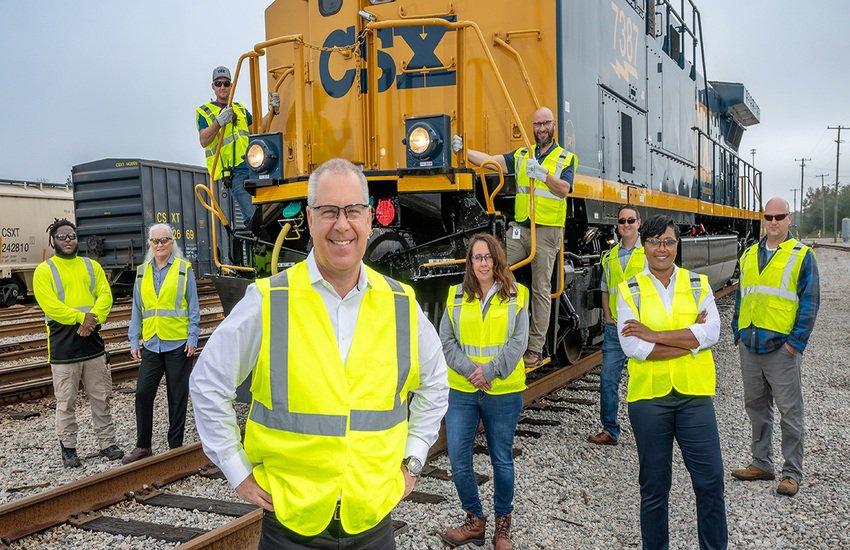The U.S. railroad sector is suddenly in flux. Just days after Union Pacific’s (NYSE:UNP) early-stage talks to acquire Norfolk Southern (NYSE:NSC) made headlines, CSX Corporation (NYSE:CSX) is now signaling that it, too, could be reevaluating its long-term path. While CEO Joe Hinrichs hasn’t directly confirmed any merger discussions, his recent comments about welcoming opportunities to “deliver shareholder value” and “drive profitable growth” hint at a broader openness to strategic alternatives — including potential deals, partnerships, or structural transformations. This comes amid a 14% year-over-year profit dip in Q2, mounting infrastructure costs from ongoing construction disruptions, and the emergence of cross-continental freight as a new strategic prize in the industry. Given the uncertainty around regulatory approvals for Class I mergers, CSX’s shift in tone may be a response to rising investor questions around competitiveness and market positioning. With capital projects set to wind down by year-end and merger sentiment building across the industry, CSX is now a name to watch closely.
Industry-Wide Consolidation Pressure Is Real & Rising
Union Pacific’s potential acquisition of Norfolk Southern could reshape the entire landscape of North American freight rail by forming a transcontinental network that runs coast to coast. This development immediately creates a sense of urgency among remaining Class I players, particularly CSX, which directly competes with Norfolk Southern across the eastern United States. If the Union Pacific–Norfolk Southern merger gains traction and regulatory momentum, CSX may find itself boxed out of the most lucrative long-haul freight corridors that run seamlessly across the country. In a market where shippers increasingly value end-to-end logistics simplicity, CSX risks losing market share or pricing power without a comparable national footprint. While regulatory resistance to railroad consolidation remains a challenge, CSX executives are aware that staying passive could be strategically disadvantageous. By expressing openness to strategic alternatives, CSX is likely signaling to investors and peers that it is not content playing defense while others chart aggressive growth paths. The company’s partnerships, like the recent deal with CPKC to connect Mexico to the U.S. Southeast, reflect attempts to expand its reach — but these partnerships may not offer the same control or revenue upside as a merger. The heightened M&A activity also reflects a broader investor appetite for large-scale consolidation in a relatively mature and capital-intensive sector. If CSX doesn't explore alternatives, it risks being left behind as competitors create vertically integrated and geographically expansive supply chains.
Operational Disruptions Have Created A Valuation Overhang
CSX’s ongoing capital projects — including the Baltimore tunnel expansion and repairs linked to Hurricanes Helene and Milton — have weighed on service metrics and financial results in recent quarters. These construction efforts have led to roughly $10 million in added costs per month, forcing re-routes, stretching asset cycles, and suppressing volumes. While management has maintained that these disruptions are temporary and set to ease in Q4, the reality is that investor sentiment around CSX’s near-term margin recovery has taken a hit. In Q2 2025, net income declined 14% YoY to $829 million, a reflection of both soft consumer-driven volumes and the cost burden of ongoing projects. The company has taken steps to cut costs — including the recent elimination of 125 management jobs projected to save $30 million annually — but its current valuation implies execution risk. In such an environment, exploring strategic alternatives could be a way to reset investor expectations, create a narrative around proactive transformation, and potentially unlock hidden value through a merger, spin-off, or strategic partnership. These actions could also help bridge near-term valuation gaps without relying entirely on organic recovery.
CSX’s Management Is Signaling Willingness, Not Resistance
CEO Joe Hinrichs’ recent remarks reflect a carefully calculated tone — confident in CSX’s standalone prospects but explicitly open to external opportunities. While he stopped short of commenting on any ongoing merger talks, he emphasized that CSX would welcome moves that enhance shareholder value and customer service. This is a notable rhetorical shift from a company that has traditionally focused on internal optimization and network efficiency. CFO Sean Pelkey also reaffirmed margin targets and financial discipline during the Q2 earnings call, but the company’s broader posture suggests it understands that shareholder expectations are evolving in the wake of UP–NSC merger discussions. Importantly, CSX has already shown flexibility in forging partnerships, such as its new interline service with CPKC that connects Mexico to the U.S. Southeast. This illustrates that CSX is not philosophically opposed to external collaborations — in fact, it appears to be actively testing the waters. These kinds of moves often serve as precursors to larger strategic decisions, especially if market conditions or competitive threats intensify. Analysts and investors alike are now parsing every comment from CSX leadership through the lens of M&A readiness, and the company's evolving tone may be laying the groundwork for more serious conversations down the line. It’s also worth noting that CSX’s board has historically acted decisively — whether in leadership transitions or capital allocation — and may support a deeper strategic review if they believe it will strengthen CSX’s long-term position.
A Maturing Market Demands Either Scale Or Specialization
The Class I freight rail industry is a relatively mature market with high fixed costs, regulatory burdens, and modest organic growth prospects. In this environment, scale economies and route diversification can provide the kind of margin and service advantages needed to stay competitive. CSX has been making incremental progress on its network efficiency and service recovery, but its current geographic footprint is limited to the eastern U.S. This leaves it exposed to macro softness in consumer goods and industrial production, which directly impacted Q2 volumes. Furthermore, the competitive landscape is shifting — Union Pacific and Norfolk Southern could potentially form a cross-country freight network that would outmatch CSX in long-haul service, while BNSF remains a formidable player in the west. CSX’s internal improvement efforts, while meaningful, may not be sufficient to outpace peers unless paired with bold strategic action. Exploring alternatives — whether a merger, joint venture, or business model transformation — could offer CSX a path to either scale up and compete on breadth or specialize further in high-margin regional services. Without such a move, CSX may struggle to distinguish itself from competitors who are actively reshaping their networks in response to market dynamics. In short, the status quo may no longer be a viable strategy, particularly as investors, regulators, and customers begin to evaluate railroads not just by performance, but by future readiness and network integration.
Final Thoughts

Source: Yahoo Finance
As we can see in the above chart, CSX’s openness to strategic alternatives has resulted in a solid spike in the stock price and the stock seems on its way to its earlier 52-week high levels. This move appears to be both reactive and proactive — a response to the unfolding Union Pacific–Norfolk Southern situation and a reflection of the internal pressures facing its own business. However, the company’s LTM valuation multiples as of July 24, 2025, show elevated figures across key metrics, including 12.75x EV/EBITDA, 17.11x EV/EBIT, and 21.47x P/E. These levels may be difficult to defend in the absence of a strong volume rebound or margin expansion in the back half of the year. At the same time, CSX is nearing the end of its major construction disruptions and has cut management costs, which could improve operating leverage by Q4. Whether it pursues a full-scale merger, regional partnership, or simply maintains its independent path, the window for inaction may be closing. The real challenge for CSX will be navigating regulatory uncertainty and balancing shareholder pressure with operational discipline — all while keeping an eye on the competitive chessboard.













